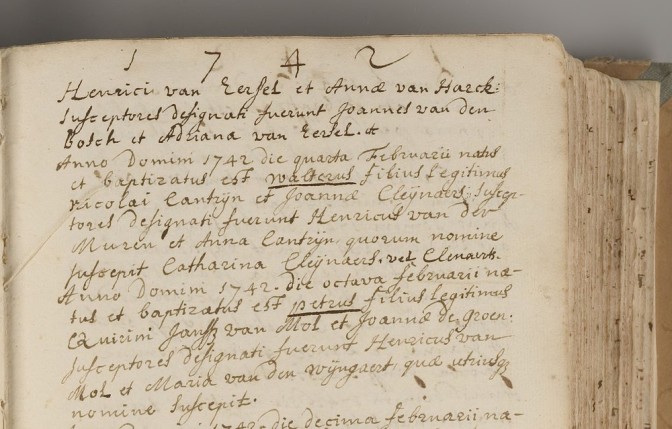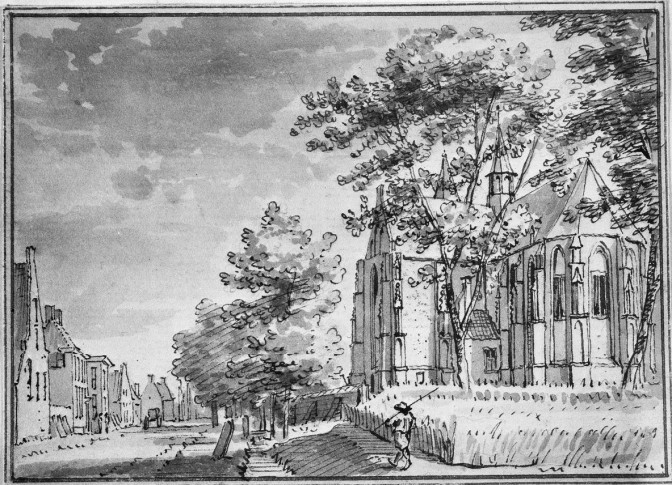Before 1811, baptismal records are the main source for information about an ancestor’s birth date. Baptismal records should have been kept since the Trente council of 1545-1563, but for most areas they only survive since the early to mid 1600s.
Most children were baptized within days of being born. In some churches, children were baptized the next Sunday. Others baptized them the same day, or may have waited several weeks. Anabaptists and similar religious only baptized adults, so in that case the baptismal date is not a good approximation of the birth date.
Information in a baptismal record
Baptismal records can provide the following information:
- Name of the child
- Date of the baptism
- Date of the birth
- Name of the father
- Name of the mother
- Names of the witnesses/sponsors/godparents
- Name of the church
- Denomination of the church
- Whether the child was legitimate or illegitimate
In general, older baptismal records provide less details than more recent records. For instance, most 17th century records don’t provide the birth date, and often even the mother’s name is absent. The names of the witnesses can be vital clues, since witnesses were often close relatives.
Roman-Catholic records were kept in Latin, Dutch Reformed (and other Protestant denominations) records were kept in Dutch.
How to find a baptismal record in the Netherlands
To find baptismal records, you need to know where the baptism took place. Perhaps you found a place of birth in the marriage record, or the death record, or found an extract of the baptismal record in the marriage supplements.
Baptismal records from before 1811 have been transferred to governmental archives as precursors of the civil registration. They are not found at the churches. The church records of baptisms, marriages and burials usually form a separate record group.
There is no nation-wide search engine to search for online baptismal records. Scans of many baptismal records are available at Familysearch. Some archives have created indexes or put higher-quality scans online at their own websites. Check the website Online Resources for Netherlands and Belgium for links.
Example: Finding the baptism of Wouter Cantrijn
Let’s take my ancestor Wouter Cantrijn as an example. I first encountered Wouter as the father of my ancestor Maria Cantrijn. She was baptized in Princenhage, Brabant, on 29 April 1779. Her parents were listed as “Walter Cantrijn uit Oudenbos” [Walter Cantrijn from Oudenbos] and Cornelia van de Laar.1
The marriage of Wouter Cantrijn and Cornelia van de Laar was recorded in the Dutch Reformed Church and the Roman Catholic Church, which was not uncommon as the Roman Catholic marriages weren’t recognized by the civil authorities. The (Latin) Roman Catholic record says:2
[1769] Die 16 aprilis. Walterus Cantrijn et Cornelia van de Laer.
[1769. On the day 16 April. Walter Cantrijn and Cornelia van de Laer].
The Dutch Reformed record is more informative:3
[margin:] getrouwd op den 16 April 1769.
Wouter Cantrijnen J:m: gebooren en laatsgewoond hebbende in den Oudenbosch thands woonachtig alhier is in ondertrouw opgenoomen met Cornelia van de Laar J:d: gebooren en woonachtig alhier, den 1 April 1769.[Married 16 April 1769.
Wouter Cantrijnen single, born and last having lived in Oudenbosch, currently living here, had banns published to marry Cornelia van de Laar, single, born and living here, 1 April 1769.]
Wouter’s death record shows that he was 76 years old when he died on 17 November 1818 and identified his father as Nicolaas.4
The evidence from these records tells us that Wouter’s baptismal record can most likely be found in Oudenbosch, a village a few miles to the west of Princenhage, around 1742. The Digital Resources website shows that the baptismal records of Oudenbosch are available as index plus scans from the website of the Regionaal Archief West-Brabant. A search for “Cantrijn” in the index located the baptismal record of a Wouter Cantrijn.5

Baptism of Wouter Cantrijn, Oudenbosch, 4 February 1742
Anno Domini 1742 die quarta Februarii natus et baptizatus est Walterus filius legitimus nicolai Cantrijn et Joannae Cleijnaers; susceptores designati fuerunt Henricus van der Muren at Anna Cantrijn, quorum nomine suscepit Catharina Cleijnaers vel Clenaerts.
[AD 1742 on the fourth day of February is born and baptized Walter, legitimate son of Nicolaas Cantrijn and Joanna Cleijnaers, as sponsors were designated Henricus van der Muren and Anna Cantrijn, in whose name Catharina Cleijnaers, also named Clenaerts, presented the child for baptism.]
This has to be the baptismal record for my ancestor Wouter Cantrijn:
- The name of the child and the father match, except for Latinization of the names
- The date of the birth matches the age of 76 in the 1818 death record
- The child was baptized in Oudenbosch, the place of origin mentioned in Wouter Cantrijn’s Dutch Reformed marriage record
- The name of his mother (Joanna) matches the name of his oldest daughter, in line with the tradition to name the eldest daughters after their grandmothers.

Oudenbosch in 17396
Using these same techniques, you should be able to find the baptismal records for your ancestors. Happy hunting!
Sources
- St. Martin’s Roman Catholic Church (Princenhage ), baptismal register 1767-1811, Maria Canterijn, 29 April 1779; digital image, “Digitale Stamboom,” Stadsarchief Breda (http://stadsarchief.breda.nl : accessed 27 October 2013)
- St. Martin’s Roman Catholic Church (Princenhage ), marriage 1741-1826, Cantrijn-van de Laer, 16 April 1769, p. 38r; digital image, “Digitale Stamboom,” Stadsarchief Breda (http://www.stadsarchief.breda.nl : accessed 23 October 2013)
- Dutch Reformed Church (Princenhage), marriage register 1746-1802, p. 34v, Cantrijnen-van de Laar, 1 April 1769; digital image, “Digitale Stamboom,” Stadsarchief Breda (http://www.stadsarchief.breda.nl : accessed 13 July 2014)
- Princenhage, death record 1818 no. 86, Wouter Canters, 17 November 1818; digital image, “Digitale Stamboom,” Stadsarchief Breda (http://www.stadsarchief.breda.nl : accessed 13 July 2014)
- Roman Catholic Church (Oudenbosch), baptismal register 1721-1806, unpaginated, Walterus Nicolai Cantrijn, 4 February 1742; digital image, “Personen,” Regionaal Archief West-Brabant (http://www.regionaalarchiefwestbrabant.nl : accessed 13 July 2014)
- Unidentified artist, “Oudenbosch in 1739”; digital image, Rijksdienst voor Cultureel Erfgoed (http://beeldbank.cultureelerfgoed.nl : accessed 4 June 2015)


It should be noted that certain Christian such as the Baptists did not accept infant baptism on grounds that a child did not have the intellectual capability to accept the Christian faith, so their baptisms often took place when they were in their mid-teens (or later). One of my ancestors, wo was born in 1789, was a Baptist and as such had no “proof” of his baptism.